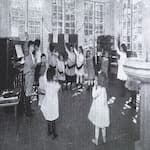The following article was printed in the Ladies' Home Journal The Ladies' Home Journal
v. 29, November, 1912
What Really is the Montessori Method
A Direct Answer to the Question Mothers are Asking
by Jay P. Elsson
Historical Note: The Ladies Home Journal was a popular publication in the early 20th Century. In 1903, it became the first American publication to have more than one million copies in circulation. This article is written by one of the more regular contributing authors, Jay P. Elsson in 1912.
When five-year-old George rebels against repeated commands to sit still, or insists on fingering everything he sees, and when three-year-old Bessie cries because she is not allowed to brush her own hair, their weary mamma pronounces them a pair of naughty children. Are they? The author of the Montessori Method would answer that they are only obeying the promptings of nature; that the way to make George more quiet is not to repress his activity by admonitions, but to give him something to do which will be interesting and at the same time educative; that it would be wiser to let Bessie brusher her hair till she learns to do it well; and, broadly speaking, that the less we do to deprive a child of his liberty, or smother his independence of spirit, the better.
Maria Montessori was the first woman graduated as a physician in Italy.* Her motherly instincts guided her choice of a specialty, which the Government in due time recognized by putting her in charge of its Orthophrenic School, where women are trained to become teachers of feeble-minded children. Here she worked out a system equally applicable to normal children with the first awakening of their intelligence. Its success, proved experimentally in some schools she established in the slums of Rome, led to its gradual introduction into other European cities and into this country, and its application to children with better parentage and surroundings.
The children brought under the Montessori method range in age from two and a half or three years to seven. It is during this period that old-fashioned parents sent their children to a day school to ahve the elements of learning pounded into their little heads, and many modern parents let theirs "run wild." Doctor Montessori opposes both practices. She gathers the children in a cheerful room and lets them amuse themselves with something neither burdensome nor silly. The teachers are not professionally known as such, but are called "directors" because their fuction is the steer the young minds, not to drive ideas into them. There are no desks and benches fastened to the floor, but movable tables and chairs light enough for children to handle. Instead of having to sit up like a stick of wood, silent and motionless, every child enters the school as free as an adult and retains his freedom always, being required only to avoid interfering with the liberty of the others. He soon learns, for instance, that he cannot rush helter-skelter about the room, banging into everybody and everything, or shouting, because that disturbs his mates. Indeed one of his first lessons consists in carrying his chair from one table to another without dropping it or hitting anything in the way.
His natural impulse to finger something is satisfied by giving him, perhaps, a frame in which are stretched two strips of cloth, their edges meeting or overlapping. One edge is faced with a row of buttons, the other with a corresponding row of buttonholes; or one with hooks and the other with eyes; or both with flying ribbons which he can tie into bowknots. Often a child who would tire of an ordinary toy in five minutes will sit for an hour immersed in buttoning, hooking, and tying. His littler fingers, awkward at first, become expert by practice. Here he has mastered on small process in dressing himself; and, as no adult has helped him, he is immensely proud of his achievement and anxious to display it to his mother by taking part of his morning toilet off her hands.
The next toy perhaps is a flat board into which several small circular holes of graded sizes have been sawed; and the game consists in setting into the holes a lot of wooden cylinders made to fit them exactly. The first set of cylinders are all the same height. The next set are of varying heights. Then a board with holes of the same size is given to the child, with cylinders of varied heights with he is to arrange in a procession according to height, the tallesat at one end and the shortest at the other. The mistakes he makes he is left to find out for himself; the director does not even tell him he has made one.
Later, games involve rising and seating himself noiselessly, kneeling and getting to his feet again, marching to music, and walking a line marked on the floor. He is given articles that toole easily to carry without spilling; such feats train both his muscles and his self-control. He is allowed to build a tower of wooden blocks of graded sizes; if he makes a mistake in the order of the size the whole tower tumbles over. The next toy is a bunch of ten rods -- each say, an inch and a half square. The shortest is about four inches long and painted red, the second eight inches and painted half red and half blue, the third twelve inches, red, blue and red in equal lengths, and so on; so that when the longest, measuring forty inches, is laid on the floor and the others are piled on it in order of length they make something like a flight of long and narrow stairs, with the red and blue colors in solid masses.
Another toy is called the "broad stair," because it consists of wooden blocks all of the same color, width, and thickness, but of graded heights, and when these are placed against each other in order of height they make a flight of broad steps. If any one is wrongly placed the ascending series is broken and the child discovers it himself.
Now comes a board with holes cut in it -- square, circular, elliptical, oval, and of other shapes common in nature -- each hole having a disk of wood which exactly fits it. The disks are shuffled up, and the pulle is to fit each hole with its own disk. The names of the several shapes are taught the child, and his natural impules is to run his fingers around the end of each hole and them around the edges of the disks till he finds one that corresponds. Sometimes, to add interest to the sport, he is blindfolded. Incidentally to the expirements with the sense of touch the child is given a chance to learn the difference between a rough surface and a smooth surface, and between hot, warm, tepid, and cold objects.
The color sense, already awakened by the red and blue rods, is further developed by tests with silks and various colors. To avoid confusion, only two strongly contrasted colors are used at first, then three; thus by degrees up to eight, and finally several different shades of these colors. The name of each color is given to the child as he goes along, so that when the director asks for red, green, or yellow the child can pick the right color from the pile; or, if one color after another is held up, he can name it. Both observation and memory may be trained by holding up some object for the child to look at attentively for a moment, and then letting him turn his eyes away and hunt through a drawer for its duplicate in color.
A diminutive washstand, with shelves to hold basin and pitcher, soapdish, nailbrush, toothbrush, towels, etc., small enough for him to handle, starts the child in dressing and undressing, dusting and wiping the shelves, and the like.
To test his hearing there is an interesting game known as "The Silence." All the children bend their heads, bury their eyes in their hands and compete in trying to keep absolutely still for a few minutes. The room is darkened, and the director tells them in a low whisper what she can hear -- the ticking of a clock, perhaps, the buzzing of a fly, the stir of the leaves in the neighboring tree, or the breathing of a little boy near by. Then the director takes her place in an adjoining room, leaving the door open and telling the children that shei s going to call their names one by one. When she whispers a name that child, who has been listening keenly, tiptoes out to her. She whispers another name, and another child follows; and so down the list. These intenseness of the silence causes the children no distress, because it is play and not rigorous school discipline, yet it teachest the strictest self-control.
A game of weighing is played with little tablets of different weights -- not of the same size. A child is blindfolded, given a tablet to hold in each hand and asked which is heavier. As the tablets are colored according to their weights the other children become greatly interested, because they can see whether their blindold friend is making a right decision.
Thus by degrees the child is brought to understand the external relations of things he sees about his, has his senses trained and is taught to concentrate his attention. He has now reached a point where his regular instruction in the practical arts of life can begin. He learns how to set a table for luncheon and clear it after a meal, and how to put a room in order.
Then comes the child's introduction to writing. In the Montessori method a written alphabet is cut out of sandpaper. Each letter, which is two or three inches high, is pasted upon a card with a smooth surface. The pupil is first allowed to run his finger over the sanded lines of a letter till he is familiar with it; then he substitutes a short stick for his finger, and does the same thing again and again. Meanwhile the director tells him the sound of the letter, and, if necessary, shows him how to put his lips together to make the sound of "/p/" or his upper teeth against his lower lip for "/f/." He now exchanges his stick for a piece of chalk, and repeats on the blackboard the motions he had made in following the sandpaper lines of the letter. Before he knows it, he is writing "p" or "f," or whatever it is, and is mightily proud of his new power.
Passing from writing to reading is difficult in the English language because of our vagaries in spelling and pronunciation. So the director chooses some simple word like "no," which she writes in a large round hand on the blackboard. She points to the first letter and the child utters the sound /n/. She points to the second land he responds with "o," but recognizes yet no connection between the combination and any word in ordinary speech. She does not enlighten him, but points to the two letters in quick succession, saying: "Faster now!" The next time: "Faster yet!" In a moment more, to his great delight, he is exclaiming, "No!" and hastening back to the blackboard to write the word himself.
With the simpler operations in number work the same general plan is employed. Having learned to write and read the figures from 1 to 10 the child is taught to add and subtract by means of the red and blue rods. He is also given a figure written on a sheet of paper, and asked to lay out in a row that number of little sticks; then to put two or three such groups of sticks together and found them up. Thus he passes from one process to another, learning the meanings of the written symbols at the same time with their forms and uses.
Most of the apparatus used in the Montessori method is of the Doctor's own invention, and a finely made set costs about fifty dollars (approx. $1600 USD in 2023). It is earier to buy or make the apparatus than to find a teacher fitted to be the director of a Children's Housse. The most devoted woman may not have the temperament needed to carry her patiently through the preliminary period while a noisy lot of children are adjusting themselves to her order of discipline.
Kindergarteners will have much to unlearn before undertaking the Montessori method, because they must avoid stimulating the child's imagination and let it wake of its own motion. The kindergarten was a protest, and a welcome one, against the forcing processes which it superseded in part. It will be seen that the Montessori method, while sharing some of the better traits of the kindergarten, has struck off a path of its own hewing; and its success in developing the reasonin powers of children still in pinafores, without the use of punishments or rewards, makes us wonder where the next step in this forward movement in education is going to land us.
*While many sources, including this one, say she Maria Montessori was the first female physician in Italy, we now know this to be inaccurate. She was definitely one of the first, and definitely the most popular and outspoken female physician at the time. It is likely she did not even know about the others.
Matt Bronsil is the author of these posts. He can be contacted at MattBronsilMontessori@gmail.com
<<< Back to the Early article list <<<
Recommended Montessori Books
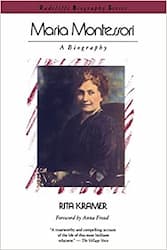
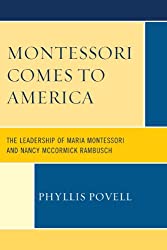
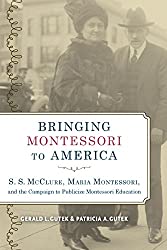
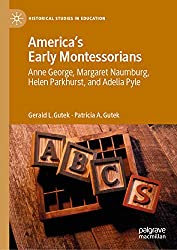
Montessori History Blogs

History of Montessori
Maria Montessori
History of Montessori in Taiwan
History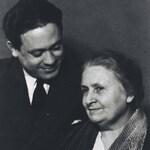
Mario Montessori
Mario Montessori
McClure's Magazine
McClure's Magazine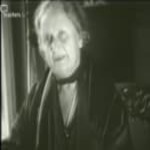
Montessori Video
Teachers TV: The Montessori Method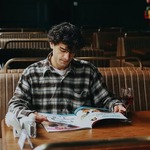
Read Old Magazine Articles
Old Montessori Articles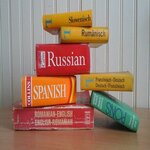
EFL and Montessori
EFL and Montessori